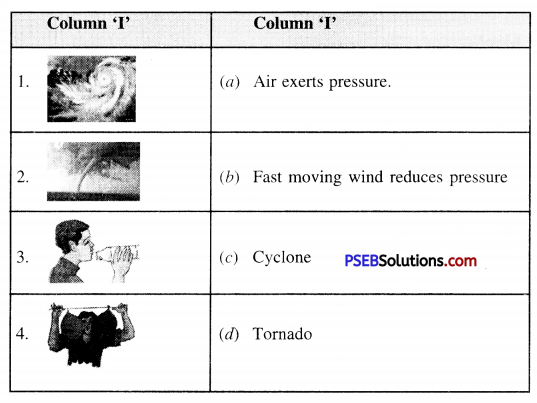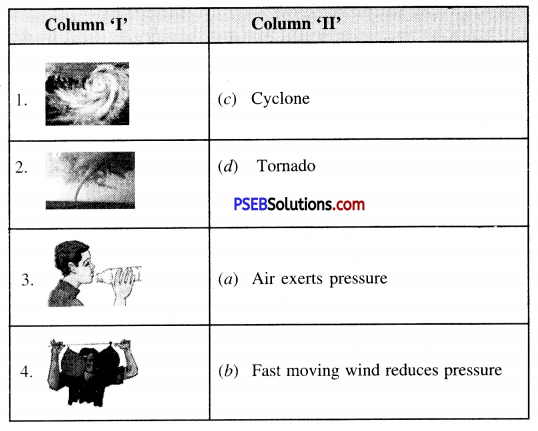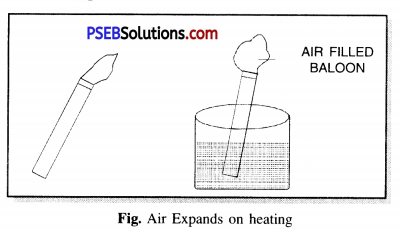Punjab State Board PSEB 7th Class Science Book Solutions Chapter 8 Winds, Storms and Cyclones Textbook Exercise Questions and Answers.
PSEB Solutions for Class 7 Science Chapter 8 Winds, Storms and Cyclones
Science Guide for Class 7 PSEB Winds, Storms and Cyclones Intext Questions and Answers
Think and answer (Textbook Page No. 85)
Question 1.
The can gets crushed because of the atmospheric pressure. (True/False)
Answer:
True.
Question 2.
Air exerts pressure. (True/False)
Answer:
True.
![]()
Think and Answer (Textbook Page No. 86)
Question 1.
Both balloons should be of equal size. (True/False)
Answer:
True.
Question 2.
The fast moving wind creates …………………. pressure.
Answer:
More.
Think and Answer (Textbook Page No. 87)
Question 1.
The air ……………. on heating.
Answer:
expands.
Question 2.
On cooling the boiling tube, the balloon expands. (True/False)
Answer:
False.
Think and Answer (Textbook Page No. 88)
Question 1.
Hot air is ……………………… than cold air.
Answer:
lighter.
Question 2.
The paper cup over the burning candle comes down as it becomes heavier. (True / False)
Answer:
False.
PSEB 7th Class Science Guide Winds, Storms and Cyclones Textbook Questions and Answers
1. Fill in the blanks:
(i) Air exerts …………………..
Answer:
Pressure
(ii) Moving air is called …………………
Answer:
Wind
![]()
(iii) Near earth the …………………. air rises up and ………………………. air comes down.
Answer:
hot, cold
(iv) Winds are generated due to ………………………….. heating of earth.
Answer:
uneven
(v) The centre of a cyclone is called its ………………. .
Answer:
Eye
2. State True or False:
(i) A bicycle tube expands when we fill air in it.
Answer:
True
(ii) Air moves from a region of low pressure to high pressure.
Answer:
False
(iii) The speed of wind can be measured by an instrument called Anemometer.
Answer:
True
(iv) Thunder is a loud sound produced by lightning.
Answer:
True
(v) We should ignore the cyclone warnings.
False
![]()
3. Choose the Correct Answer:
Question (i)
Which of the following is not an example of air exerting pressure ?
(a) Flying a kite
(b) Filling air in bicycle tube
(c) Filling air in balloon
(d) Hot air balloon.
Answer:
(d) Hot air balloon.
Question (ii)
Moving air is called ………………… .
(a) Wind
(b) Cyclones
(c) Lightning
(d) Storm.
Answer:
(a) Wind.
Question (iii)
Which is the property of air ?
(a) Expands on cooling
(b) Contracts of heating
(c) Expands on heating
(d) None of the above.
Answer:
(c) Expands on heating
Question (iv)
Winds are produced due to ……………………. .
(a) Heating of air
(b) Cooling of land
(c) Heating of water
(d) Uneven heating of land and water.
Answer:
(d) Uneven heating of land and water.
Question (v)
High speed winds can cause …………………… .
(a) Thunderstorms
(b) Cyclones
(c) Tornado
(d) All of the above.
Answer:
(b) Cyclones
4. Match the Column ‘I’ with Column ‘II’:

Answer:

5. Very Short Answer Type Questions:
Question (i)
Which property of air is described by the inflated balloon ?
Answer:
Moving air exerts pressure.
![]()
Question (ii)
Which is lighter, cold air or hot air ?
Answer:
Hot air is lighter than cold air.
Question (iii)
Which region of earth gets maximum heat from the sun ?
Answer:
Equator and its adjoining areas are exposed to direct sunlight for a long time, resulting in higher temperatures in the vicinity of the equator.
Question (iv)
Which winds bring rain in India ?
Answer:
Rainfall in India is caused by monsoon winds. These winds filled with water vapour come from the sea.
Question (v)
Name the instrument used for measuring the speed of wind.
Answer:
Wind / air speed can be measured with an Anemometer.
6. Short Answer Type Questions:
Question (i)
Why are the holes made in hanging banners and hoardings ?
Answer:
Holes are made on hanging banners and advertisements so that they cannot be blown away due to blowing winds or wind pressure. The air will pass through the holes and there will be no pressure on the banner.
Question (ii)
In which situation does the uneven heating of the earth produces winds ?
Answer:
The sun does not heat different parts of the earth uniformly. So there is a difference in temperature and pressure. The wind that moves from a high pressure area to a low pressure area is called a wind. The higher the pressure, the higher is the wind speed.
Question (iii)
Which winds blow from ocean to land in summer ? What is their significance ?
Answer:
In summer season, the air near the surface of the earth becomes warmer and lighter and rises upwards. The air above the sea is colder and heavier than the air on the earth. So the wind moves from the ocean to the land. This cool breeze from the ocean is called Sea breeze. Due to this breeze, the weather is very pleasant for the people living near the coastal areas.
![]()
Question (iv)
What is the difference between a thunderstorm and a cyclone ?
Answer:
Thunder Storm.
Lightning strikes thunderstorms and heat up the air to a higher temperature, causing the air to expand faster and produce a louder sound. This loud sound is called thunder. The wind that blows with rain is called a storm. Sometimes a storm is accompanied by a thunder, which is then called a thunderstorm.
Cyclone.
When water takes up heat from the atmosphere to change it into vapours for the formation of cloud. These water vapours cool and condense to form raindrops and release the absorbed heat. This heat causes the surrounding air to heat up and form a low pressure area. A strong wind blows towards this low pressure center. This action is repeated several times to form a low pressure area and dense clouds from the center of a strong wind.
Many layers of high winds begin to revolve around the low pressure center. This condition is called a cyclone. Center of the storm is a quiet area called the Eye of cyclone. The area of the eye is free from clouds. Outside the Eye is a circle of clouds and thunderstorms. The wind blows here at a speed of 150 to 250 kilometre per hour.
Question (v)
State effective measures to be taken in areas vulnerable to cyclones ?
Answer:
Effective safety measures to be adopted in areas prone to post-cyclone :
1. Measures to be taken by the government :
- Tall and dense trees of native species should be planted on the coastal areas to reduce wind/wind speed.
- Ponds should be constructed in coastal areas to absorb excess water.
- Cyclone shelters should be constructed in cyclone sensitive areas.
- To issue early warning to the people of the affected area by adopting advance information technology.
2. Measures that can be adopted by the people :
- Do not ignore cyclone warnings.
- Areas that have frequent cyclones should be evacuated.
- Make appropriate arrangements to move their livestock, valuables and household members to safer places.
Question (vi)
What is a Tornado ? Give two safety measures.
Answer:
Tornado. It is strong rotating winds in Funnel shaped cloud. Its diameter varies from 1 m to 1 km. On account of very low pressure at the centre of the funnel it pulls the dust, debris and even people and vehicles towards the centre.
Safety measures from Tornado:
- Take shelter inside a room, having no window. If a room without window is unavailable then closed all doors and windows.
- If a person is in the vehicle or driving, he should get out of it and sit in low laying area.
- Whenever you face tornado you can protect yourself by sitting on your knees and
putting down your head by wrapping arms around your neck.
7. Long Answer Type Questions:
Question (i)
Explain why does a tin can get crushed when water is boiled in it and after closing it cold water is poured on it ?
Answer:
When water is boiled in an iron container, all the air in the container heats up and becomes lighter and rises upwards. In this way all the air in the box goes out. On further heating, the boiling water turns into steam and the can is filled with water. Covering the vessel with a lid ensures that the vapours are trapped inside the container. This reduces the air pressure inside the box compared to the outside air. In this way on pouring cold water the outside air pressure causes the box to shrink inwards.
Question (ii)
Explain with an activity that air expands on heating.
Answer:
Air expands by heating. This fact can be proved by the following activity:
Activity.
Take a thick glass test tube. Tightly tie a balloon over its mouth with tape. Take hot water in a beaker. Place the test tube in the water such that balloon stays out of the water. Watch the balloon for 3-4 minutes to look for any change in the size of balloon. Now take out the test tube from water and let it cool down to normal temperature. In another beaker take a small amount of ice cold water and place the test tube carrying balloon in the beaker. Wait for 3-4 minutes. Observe the change in size.
You will notice that the balloon placed in hot water swells (increases in size) after some time and the balloon when on the other placed in cold water shrinks (decreases in size).
Conclusion.
When the test tube is placed in hot water, the air in the balloon heats up and expands causing the balloon to inflate. This indicates that the air expands on healing. When the test tube is placed in ice, the air present in balloon contracts. It shows cooling causes air to contraction.
Question (iii)
How is a cyclone formed ? Describe how a cyclone caused widespread destruction in Odisha in 1999.
Answer:
Formation of Cyclone.
When water takes up heat from the atmosphere to change it into vapours for the formation of cloud. These water vapours cool and condense to form raindrops and release the absorbed heat. This heat causes the surrounding air to heat up and form a low pressure area. A strong wind blows towards this low pressure center. This action is repeated several times to form a low pressure area and dense clouds from the center of a strong wind.
Many layers of high winds begin to revolve around the low pressure center. This condition is called a cyclone. Center of the storm is a quiet area called the Eye of cyclone. The area of the eye is free from clouds. Outside the Eye is a circle of clouds and thunderstorms. The wind blows here at a speed of 150 to 250 kilometre per hour.
Destruction caused by cyclone in Odisha. A very strong cyclone strike to Indian state Odisha on 18 October, 1999. The speed of this cyclone was 200 km/h and it destroyed 45000 houses leaving 70,000 people homeless. Again on 29th October 1999 a cyclone hits Odhisa with a speed of 260 km/h accompanied by 9 meter high wave. Many people lost their lives and property worth of crores was destroyed.
![]()
PSEB Solutions for Class 7 Science Winds, Storms and Cyclones Important Questions and Answers
1. Fill in the blanks:
(i) Wind is air.
Answer:
moving
(ii) Winds are generated due to heating on the earth.
Answer:
uneven
(iii) Near the earth’s surface air rises up whereas air comes down.
Answer:
warm, cooler
(iv) Air moves from a region of pressure to a region of pressure.
Answer:
high, low
2. Match the Column ‘I’ with Column ‘II’:
| Column ‘I’ | Column ‘II’ |
| (i) Hot air | (a) Low pressure area of the cyclone |
| (ii) Changes in atmospheric pressure cause | (b) Sunlight |
| (iii) The eye of the cyclone | (c) Blows away the roof |
| (iv) High speed air over the roof | (d) Winds, storms and cyclones. |
Answer:
| Column ‘I’ | Column ‘II’ |
| (i) Hot air | (b) Sunlight |
| (ii) Changes in atmospheric pressure cause | (d) Winds, storms and cyclones |
| (iii) The eye of the cyclone | (a) Low pressure area of the cyclone |
| (iv) High speed air over the roof | (c) Blows away the roof |
3. Choose the Correct Answer:
Question (i)
Which of the following place is likely to be affected by a cyclone?
(a) Amritsar
(b) Chennai
(c) Delhi
(d) Jaipur
Answer:
(b) Chennai
Question (ii)
An instrument used to measure wind speed is called ………………. .
(a) Anemometer
(b) Barometer
(c) Thermometer
(d) Lactometer.
Answer:
(a) Anemometer.
![]()
Question (iii)
How many hours in advance cyclone chart is issued of expected storm by satellites and radars ?
(a) 72
(b) 48
(c) 96
(d) 12
Answer:
(b) 48
Question (iv)
Which winds carry water and bring rain ?
(a) Unequal
(b) Equal
(c) Monsoon
(d) None of the above.
Answer:
(c) Monsoon.
Question (v)
A dark funnel shaped cloud that reaches from sky to the ground is called ……………….
(a) Wind
(b) Tornado
(c) Cyclone
(d Monsoon.
Answer:
(b) Tornado.
Question (vi)
Hurricane in America, Typhoon in Japan are nothing but ………………. only.
(a) Cyclones
(b) Tornado
(c) Monsoon wind
(d) Thunder storms.
Answer:
(a) Cyclones.
Question (vii)
In which year did Orissa was hit by a cyclone ?
(a) 1999
(b) 2000
(c) 2001
(d) 2004.
Answer:
(a) 1999.
State True or False:
(i) Wind always blows from low pressure area to high pressure area.
Answer:
False
(ii) Wind speed is measured with an anemometer.
Answer:
True
![]()
(iii) Heavy rains accompanied by strong winds are called cyclones.
Answer:
False
(iv) A hurricane is a storm with strong winds blowing through a funnel-shaped cloud.
Answer:
True
Very Short Answer Type Questions
Question 1.
What disaster fell on 18 October, 1999 in India ?
Answer:
A cyclone hits Orissa.
Question 2.
When did second cyclone hit Orissa ?
Answer:
29 October, 1999.
Question 3.
What was the number of homeless people hit by cyclone ?
Answer:
About 700000 people.
Question 4.
What is wind ?
Answer:
Air in motion.
Question 5.
Give the characteristic of air.
Answer:
Air exerts pressure.
![]()
Question 6.
Why do we fill air into bicycle tubes ?
Answer:
To keep the tube tight so that it can run smoothly on a surface.
Question 7.
What happens to air pressure when speed of wind is increased ?
Answer:
Air pressure reduces.
Question 8.
Why does hot air move upwards ?
Answer:
Because it is lighter than cold air.
Question 9.
What are monsoon winds ?
Answer:
Monsoon winds are those winds which come from the oceans and seas and carry water with them and bring rain.
Question 10.
Name few natural disasters caused by wind.
Answer:
Cyclones, thunder storms, tornadoes etc.
Question 11.
In winter what is direction of winds ?
Answer:
From land to oceans.
Short Answer Type Questions
Question 1.
What is a cyclone ? On which factors it depends ?
Answer:
Cyclone. A low pressure system with very- high speed winds revolving around it is called cyclone.
Wind speed, wind direction, humidity and temperature are some factors which contribute to the development of a cyclone.
![]()
Question 2.
Give a brief account of formation of thunderstorms.
Answer:
In hot, humid climate, the rising temperature produces strong winds. These rise upwards and carry lot of water droplets. These water droplets freeze at height and fall downwards. The swift falling water droplets along with rising air produce lightning and sound. This phenomenon is called thunderstorm.
Question 3.
How are clouds important to farmers ?
Answer:
Importance of clouds to farmers.
- Clouds are important for harvest. If harvest is good, farmers are happy.
- Clouds bring rains.
- They make the weather pleasant.
Question 4.
How will you help your neighbours in case cyclone approaches your village/town ?
Answer:
Helping neighbours during cyclones:
- Moving them to cyclone shelters.
- Shifting their household property to safer places.
- Providing them medical aid.
Question 5.
What planning is required to deal with situation created by a cyclone ?
Answer:
Plans to deal with situation created by cyclone.
- Shift essential household good, domestic animals to safer places.
- Keep handy phone numbers of all emergency services like Police, fire brigade and medicle centres.
- Avoid driving on roads with standing water.
Long Answer Type Questions
Question 1.
How will you show air expands on heating ?
Answer:
Experiment to show air expands on heating. Take a boiling tube and fix a balloon tightly over the neck of the tube. Insert the boiling tube carrying balloon into a beaker containing hot water.
Watch the balloon for 2-3 minutes you will notice that the balloon has start inflating. This experiment shows that air expands on heating.

Question 2.
What precautions should be taken when a thunderstorm is accompanied by lightning?
Answer:
Precautions to be taken during lightning in thunderstorms accompanied by lightning:
- Never take shelter under an isolated tree.
- Do not lie on the ground.
- Do not use an umbrella having a metallic rod.
- Window, open garages, storage sheds, metal sheds are not safe places.
- Never stay in the water.
- Inside a car or bus is a safe place to take shelter.
